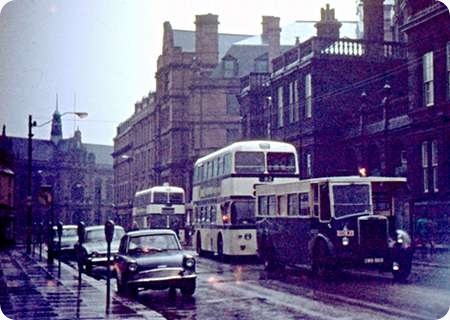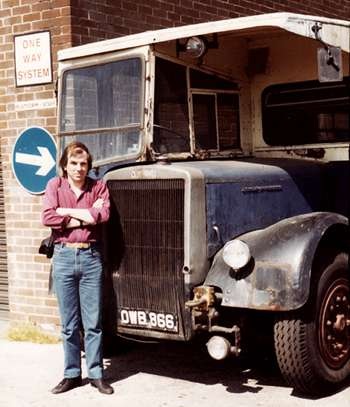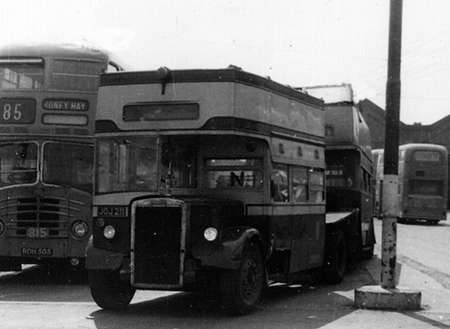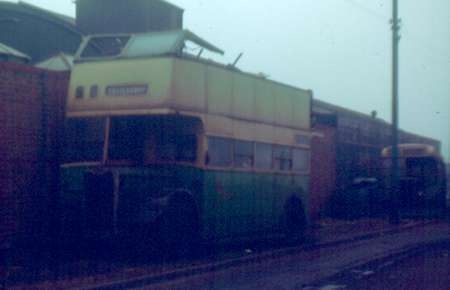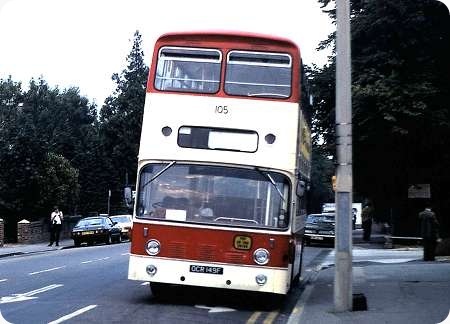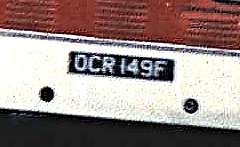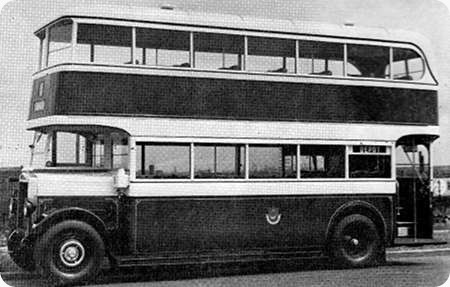Sheffield Corporation – Leyland Titan PD2 – OWB 866 – G56
Sheffield Corporation
1952
Leyland Titan PD2/10
Leyland (previously H33/26R)
This is my only photo of G56 in action doing what it did so often in the 1960s, recovering an errant PDR1/2 Atlantean in this case on a very wet day in Leopold Street, Sheffield.
G56 was converted from fleet number 666 as a gritter/tow wagon in 1966. Three of the batch were put on one side for conversion, 662 as a tower wagon to replace AEC Regent CWJ 410 and 667 as a driver trainer but in the event only the gritter conversion went ahead. It was a standard Sheffield conversion, lop off the top deck, take away the drop rear frame extension and install a doorway into what was the lower deck gangway. Random buses were modified in this way over the years when the Transport Department had to stand on its own feet when snow fell as Local Authority road gritting was not commonplace.
Photograph and Copy contributed by Ian Wild
03/02/14 – 13:55
This type of conversion continued into PTE days with at least one ex Doncaster bus getting the treatment in addition to a number of ex Sheffield PD3s and an ex Severn of Duncroft example.
Chris Hough
03/02/14 – 17:09
Small point. It was originally a 58 seater. The first 59 seaters were the 1957 PD2s (ECW, Roe and Weymann).
Nice atmospheric shot of Leopold Street in its one way phase with the Town Hall and Beethoven House (and Wilson Peck’s music shop) in the far distance and the Education Offices in the near distance. The latter have been redeveloped into upmarket boutiques and restaurants – the bit out of sight on the West Street corner was what originally was a college which eventually became Sheffield University. Leopold Street was named after the Prussian Prince Leopold.
The broken down Atlantean had its body built in Sheffield. Why did so many Atlanteans fail in the ’60s? Sheffield bought around 100 PDR1/2s between 1964 and 1966 – by far the worst and least reliable of all Atlantean variants!
David Oldfield
04/02/14 – 07:46
What a wonderful old workhorse this machine was; in the heady days when Atlanteans were hove to all over the city, with engine covers raised and pools of oil gathering underneath, I doubt G56 ever really cooled down. I still consider it a great shame that this splendid old PD2 ended up getting scrapped and not preserved, even though half of it was already missing!
Dave Careless
04/02/14 – 07:47
The problem with the PDR1/2 seemed to be in the combination of Leyland engine and Daimler gearbox which didn’t appear to work very well, was it something to do with the power produced by the Leyland engine being too much for a gearbox designed to be coupled with a Gardner slogger? Certainly the Manchester examples never sounded quite right compared to either a PDR1/1 or a Gardner engined Fleetline. I used to enjoy travelling on the back seat downstairs on a BND-C or END-D PDR1/2 for an exciting combination of excessive heat and interesting mechanical smells!
Michael Keeley
04/02/14 – 13:44
Apologies for submitting a photo with myself in it, but I thought in this instance it might be forgivable. On holiday from Canada in the spring of 1984, I caught up with G56 in a sorry looking state at the SYPTE Meadowhall Training Centre in Sheffield, out of use and presumably awaiting the scrapman. Unfortunately, there was nobody in authority to whom I could beg, plead or otherwise come to an agreement with about acquiring the much coveted registration plate! Note that somebody has already taken it upon themselves to ‘rescue’ the ‘Leyland’ radiator badge! OWB 866 was thirty two years old by this time, had worked hard all its life, and didn’t owe anybody anything.
Dave Careless
04/02/14 – 13:46
According to my information, the power outputs of the engines contemporary with the Atlantean PDR1/2 were as follows. The Gardner 6LX developed 150 bhp at 1700 rpm, with a maximum torque of 485 lb. ft. at 1050 rpm. The corresponding figures for the later 6LXB were 180bhp at 1850 rpm, and 536 lb. ft. at 1050 rpm. For the Leyland engines in bus applications, these became, for the O600, 125 bhp at 1800 rpm, and 410 lb.ft. at 1100 rpm. The O680 gave 150 bhp at 1800 rpm and 450 lb. ft. torque at 1100 rpm. The ‘Power Plus’ O.680 gave 200 bhp at 2200 rpm, and 548 lb. ft. at 1200 rpm., but this engine was not employed in the Atlantean. These figures did sometimes vary with differing applications, but not by much. The Gardner engines were lighter than their Leyland equivalents, though not so compact in design. It is unlikely, therefore, that the torque of the Leyland engines was responsible for transmission problems in the PDR1/2.
Roger Cox
05/02/14 – 09:29
Here is an ex Birmingham PD2 in use as a towing wagon, but in this case by a scrapman. Photo taken at Walsall depot, 1970
I don’t remember what the vehicle was being towed, but appears to have had an argument with a low bridge.
Tony Martin
05/02/14 – 13:54
Note in the background, yet another quaint destination on Walsall Corporation No.315 : "Boney Hay".
Stephen Ford
06/02/14 – 06:36
It’s actually 815, a Leyland PD2/12 with Roe body. The destination is a reminder that Walsall, like neighbouring Wolverhampton, ran well outside its own boundaries.
Tony Martin
07/02/14 – 18:04
I wasn’t aware until this discussion that there was a known transmission problem with the PDR1/2. Leyland were aware of a weakness in the Daimler gearbox at that time, which caused them to refuse to supply PDR1/2s with O.680 engines in standard Atlantean fettle, but the standard O.600 should not have been a problem.
Manchester specified derated O.680s for durability rather than extra power, and had them rated at 130bhp. This was the same as the derated 6LXs in the Fleetlines, but I don’t have torque figures for either. As a passenger I did notice a tendency to slip in top gear, but that was no worse than on the Fleetlines.
I know exactly what Michael means about Manchester’s PDR1/2s not sounding "right", but this seems to have been confined to Manchester, and was probably due to them having strangulated O.680s instead of standard O6.00s.
Peter Williamson
07/02/14 – 18:46
The Daimler gearbox of that era was not a very robust unit with excessive band wear evident resulting from poor driving standards (2nd gear restarts/full throttle gear changes). The Mk3 version with wider brake bands made a significant improvement about 1971 followed by a ‘self wrapping’ 2nd speed band by 1975 (we called these the Mk4 although this was not an official Daimler/Leyland classification). The Fleetline used a trailing link coupling between flywheel output and gearbox input throughout its life. This was intolerant of misalignment usually down to failing rear engine mountings, again these were substantially improved by the early 70s. I have never seen under the bonnet of a PDR1/2, does anyone know whether it used the Daimler coupling or a short propshaft between flywheel and gearbox? The Leyland 600/680 engine was shorter than a 6LX giving more space. All sorts of reasons why the PDR1/2 was so poor compared with the standard PDR1/1. (Memory suggests that the Leyland engine Fleetline used a short propshaft – mind you, they were never as good as the Gardner version)
Ian Wild
27/02/14 – 07:34
The reason that the PDR1/2 Atlantean model suffered problems was due to the adoption of an Albion Lowlander dropped centre axle
Daimler supplied the right angle drive gearbox, as the Leyland PDR1/1 design could not be used.
In Sheffield a fleet of 99 PDR1/2 chassis were ordered. Disaster occurred in 1965 when a late duty to Worksop by an East Lancs bodied PDR1/2 shed its rear axle gearing when the Albion designed unit broke up. All the Sheffield PDR1/2 buses were returned for repair and modification over many months.
Keith Beeden
27/02/14 – 10:55
As far as I’m aware, the weakness of the PDR1/2 was in leakage from the flywheel oil seal – this would be consistent with ‘pools of oil’ and ‘slipping in top gear’. The oil seal itself was presumably every bit as good as the ones fitted to other marques, so the implication is that there was something about the transmission which upset the apple cart. I do recall that with the PDR1/2s there was noticeable vibration at moderate to high revs in the indirect gears.
David Call
28/02/14 – 07:52
That’s interesting Keith. I hadn’t realised that the rear axle in the PDR1/2 was such a problem. No doubt Sheffield’s hills exacerbated the problem. Does anyone know if the weakness in the rear axle also affected Lowlanders.
Ian Wild
30/11/14 – 10:29
In the picture of the Birmingham PD2 towing a bus at Walsall, could this be the bus behind. I had taken the photo at Wolverhampton Falling Road Depot in the late 1960s
Philip Savin
Quick links to the - Comments Page - Contact Page - Home Page
